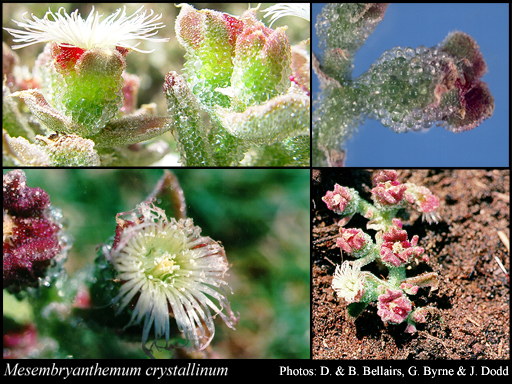- Reference
- Sp.Pl. [Linnaeus] 1:480-481 (1753)
- Conservation Code
- Not threatened
- Naturalised Status
- Alien to Western Australia
- Name Status
- Current
Prostrate, succulent annual or biennial, herb, 0.1-0.15 m high. Fl. white, Sep to Dec. Sand, clay loam. Coastal sand dunes, saline flats, roadsides.

Distribution
- IBRA Regions
- Avon Wheatbelt, Carnarvon, Coolgardie, Esperance Plains, Geraldton Sandplains, Hampton, Little Sandy Desert, Mallee, Murchison, Nullarbor, Swan Coastal Plain, Yalgoo.
- IBRA Subregions
- Cape Range, Eastern Goldfield, Edel, Geraldton Hills, Hampton, Lesueur Sandplain, Mardabilla, Merredin, Nullarbor Plain, Perth, Recherche, Rudall, Southern Cross, Western Mallee, Western Murchison, Wooramel.
- IMCRA Regions
- Abrolhos Islands, Leeuwin-Naturaliste, Shark Bay.
- Local Government Areas (LGAs)
- Carnarvon, Cockburn, Dalwallinu, Dowerin, Dundas, East Pilbara, Esperance, Exmouth, Fremantle, Greater Geraldton, Irwin, Kalgoorlie-Boulder, Kellerberrin, Kent, Kulin, Lake Grace, Northampton, Quairading, Rockingham, Shark Bay, Tammin, Trayning, Wyalkatchem, Yalgoo, Yilgarn.
Management Notes (for the Swan NRM Region)
General Biology. Growth form. Herb. Life form. Annual. Reproduction. Seed. Dispersal. Animals (by ingestion) including rabbits and mice, possibly water and wind. Toxicity. Contains potentially toxic levels of oxalate, which may cause stock poisoning. Seedbank persistence. 20+ years.
Notes. May be biennial. Its ability to accumulate salt has enabled it to establish in saline areas across southern Australia. Grazing, disturbance, and/or coastal erosion can create open habitats that encourage colonisation and spread. Invades coastal islands and bluffs where it forms dense groundcover that outcompetes native species. Abundance tends to vary from year to year depending on climatic factors, particularly winter-spring rainfall. Covered in large bladder cells. Insect-pollinated. Able to absorb significant moisture from soil and outcompete most other species for water. High levels of nitrate can build-up underneath plants and be detrimental to other species. Accumulates salt over its life time and then releases this into the surrounding soil when plants die. The increased salinity can prevent or retard other less salt-tolerant native species from establishing. Seedlings have rapid vegetative growth until spring. Growth slows and then stops as the hot, dry summer season progresses. Can switch from C3 photosynthesis to Crassulacean Acid Metabolism (CAM) in later stages of lifecycle with the onset of drought to minimise water loss and ensure reproduction without rain and in saline soils. Onset of flowering is accelerated by environmental stress, particularly salt stress. Most plants die with the onset of drought but in moist situations they may continue to grow for another season. South Australian biotypes have developed resistance to Group B/2 herbicides (including chlorsulfuron).
Additional information. Origin. South Africa, Mediterranean region. History of use/introduction. Sand used in ships' ballast, erosion control, ornamental. Similar exotic species. Mesembryanthemum nodiflorum, M. aitonis.
Suggested method of management and control. Hand remove isolated plants through spring and early summer. Logran® at 12.5 g/100L + the penetrant Pulse ® is very effective with little offtarget damage in coastal heathlands. Read the manufacturers' labels and material safety data sheets before using herbicides. For further information consult the Australian Pesticides and Veterinary Medicines Authority to determine the status of permits for your situation or state.
Management Calendar
| Calendar Type | Jan | Feb | Mar | Apr | May | Jun | Jul | Aug | Sep | Oct | Nov | Dec | Comments |
|---|---|---|---|---|---|---|---|---|---|---|---|---|---|
| Germination | Y | Y | Y | O | O | ||||||||
| Active Growth | O | O | Y | Y | Y | Y | Y | Y | |||||
| Flowering | O | O | O | O | O | O | O | O | Y | Y | Y | Y | |
| Fruiting | Y | O | O | O | O | O | O | O | O | Y | Y | Y | |
| Manual Removal | O | O | Y | Y | Y | Y | Y | Y | Y | ||||
| Herbicide Treatment | O | Y | Y | Y | Y |
Legend: Y = Yes, regularly, O = Occasionally, U = Uncertain, referred by others but not confirmed.
References
- Adams, P., Nelson, D.E., Yamada, S., Chmara, W., Jensen, R.G., Bohnert, H.J. & Griffiths, H. (2008) Growth and development of Mesembryanthemum crystallinum (Aizoaceae). New Phytologist, 138 (2): 171 - 190.
- Bohnert, H.J., Ostrem, J.A., Cushman, J.C., Michalowski, C.B., Rickers, J., Meyer, G., deRocher, E.J., Vernon, D.M., Krueger, M., Vazquez-Moreno, L., Velten, J., Hoefner, R. & Schmitt, J.M. (1988) Mesembryanthemum crystallinum, a higher plant model for the study of environmentally induced changes in gene expression. Plant Molecular Biology Reporter, 6 (1).
- Brown, K. & Brooks, K. (2002) Bushland Weeds: A Practical Guide to their Management. Environmental Weeds Action Network, Greenwood.
- Hussey, B.M.J., Keighery, G.J., Dodd, J., Lloyd, S.G. & Cousens, R.D. (2007) Western Weeds. A guide to the weeds of Western Australia. 2nd Edition. The Plant Protection Society of Western Australia, Victoria Park.
- Moore, C.B. & Moore, J.H. (2002) Herbiguide, the pesticide expert on a disk. Herbiguide, PO Box 44 Albany, Western Australia, 6330.
- Plants for a future (Undated) Plant Database. Plants For A Future, England and Wales. URL: http://www.pfaf.org/index.php - Accessed April 2010.
- Randall, J. (Undated) Invasive plants of California's wildland Mesembryanthemum crystallinum. California Invasive Plant Council URL: http://www.cal-ipc.org/ip/management/ipcw/pages/detailreport.cfm@usernumber=13&surveynumber=182.php - Accessed May 2010.
- United States Department of Agriculture (2001) The Plants Database, Version 3.1. URL: http://plants.usda.gov - Accessed December 2007. National Plant Data Center, Baton Rouge, LA 70874-4490 USA.
- Vivrette, N.J. & Muller, C.H. (1977) Mechanism of invasion and dominance of coastal grassland by Mesembryanthemum crystallinum. Ecological Monographs, 47 (3): 301-318.
- Watson, P. (2007) Warming to the ice plants: Introducing the Ice Plants. The Tasmanian Naturalist, 129: 8-15 URL: http://www.apstas.com/iceplants.html - Accessed February 2010.